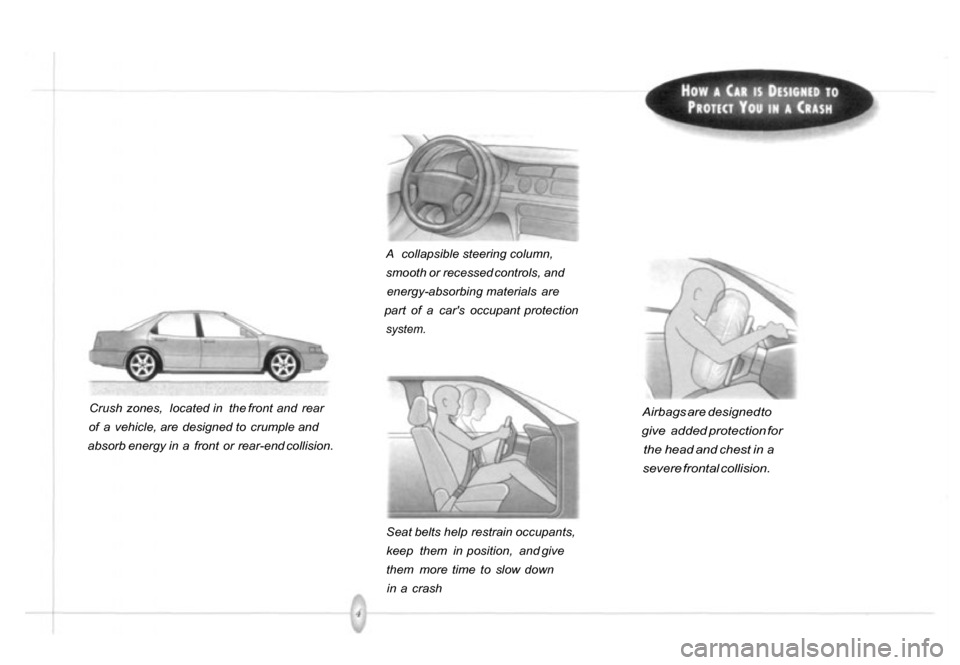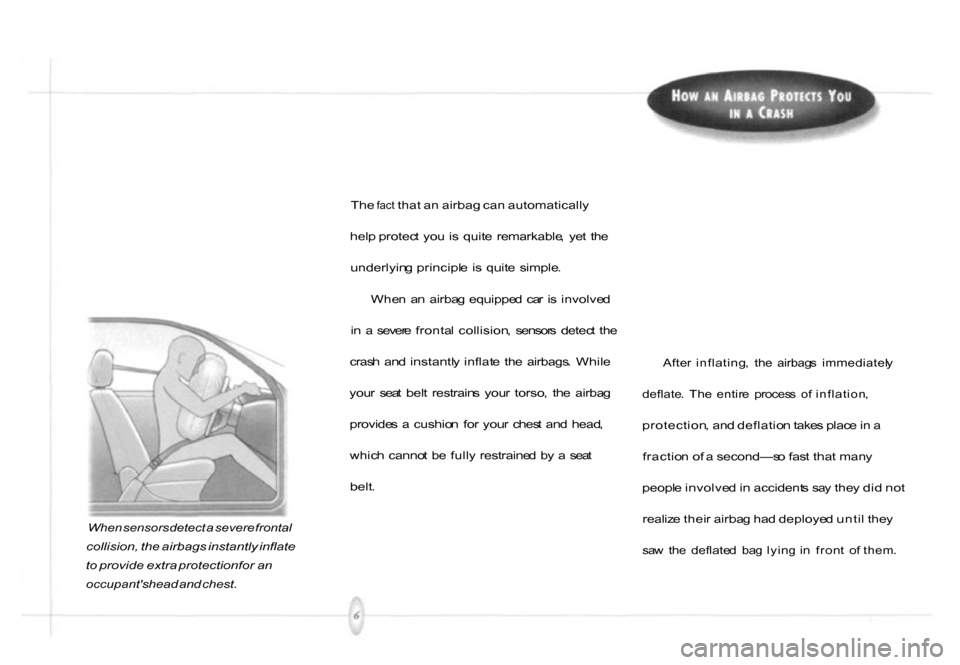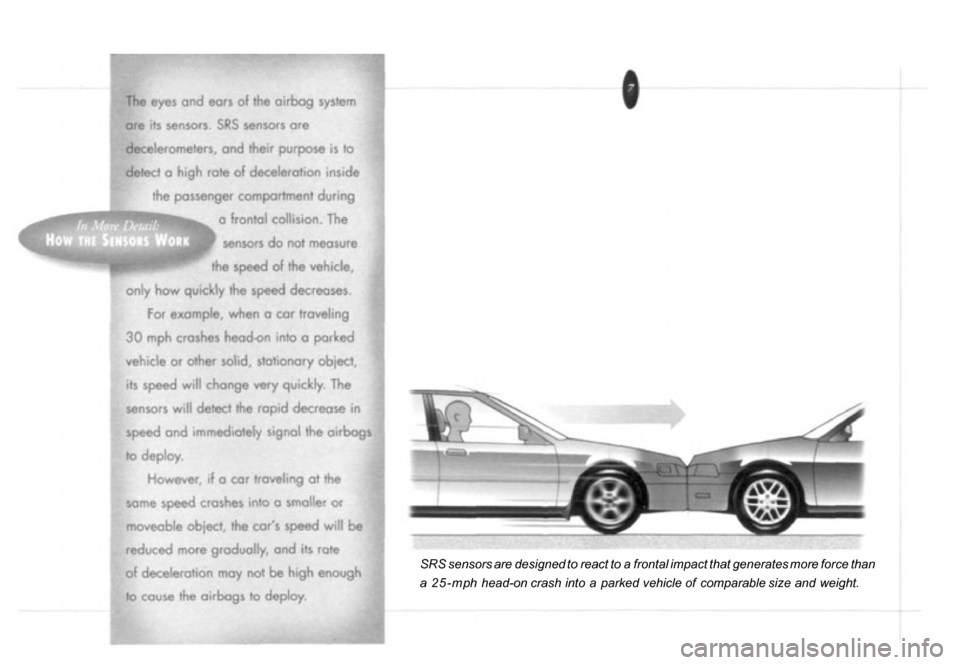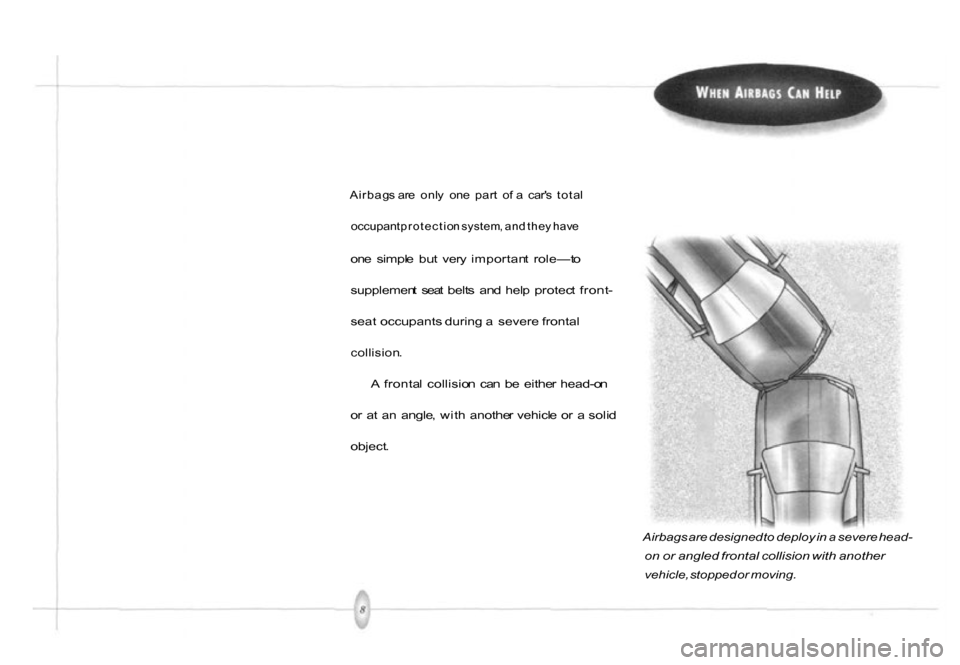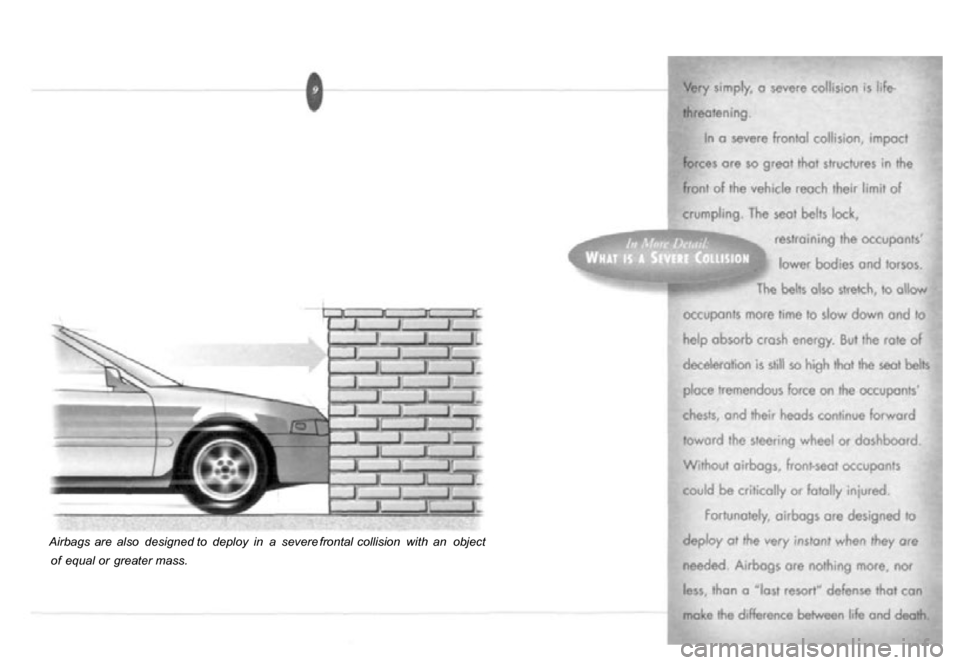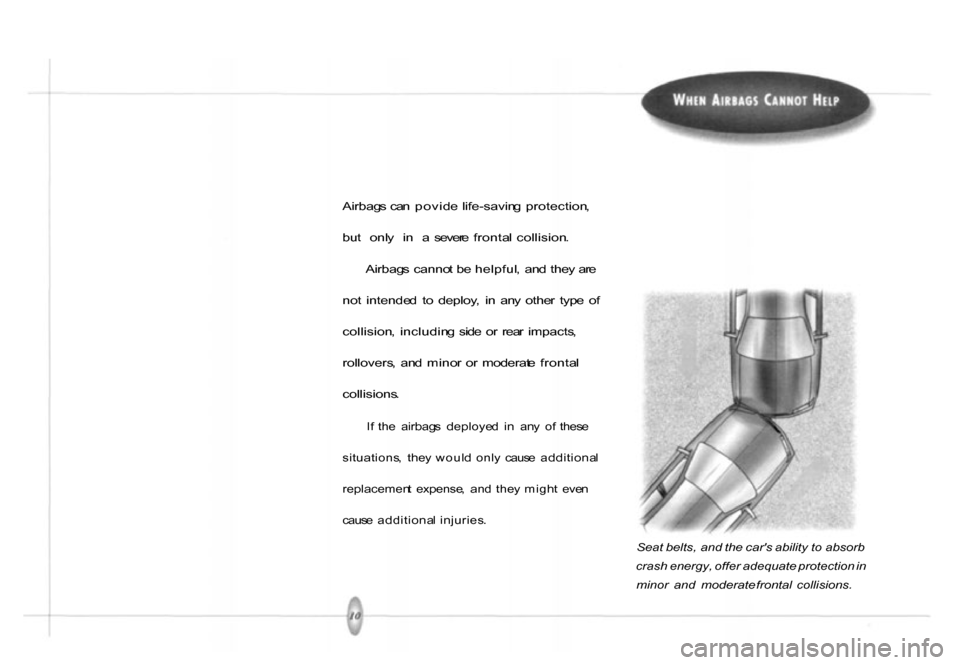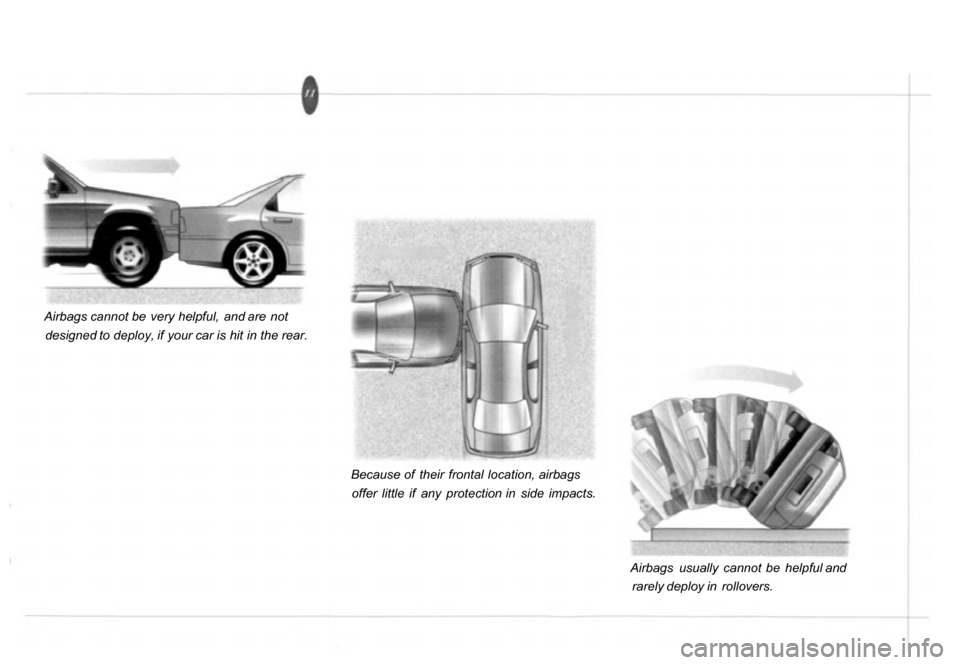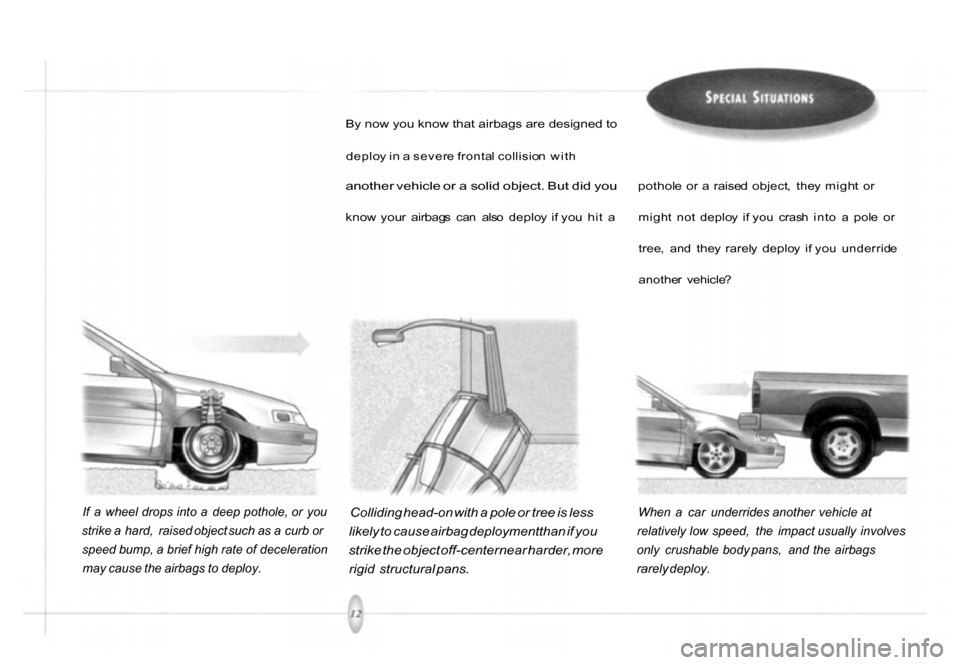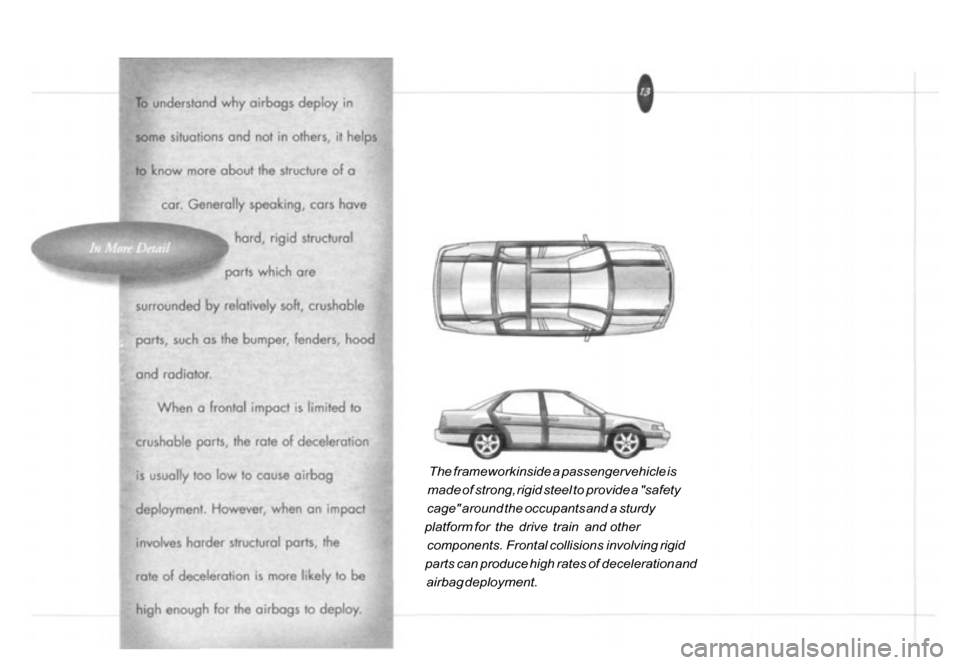HONDA PASSPORT 2001 2.G Owners Manual
PASSPORT 2001 2.G
HONDA
HONDA
https://www.carmanualsonline.info/img/13/5996/w960_5996-0.png
HONDA PASSPORT 2001 2.G Owners Manual
Trending: cooling, mirror controls, tow bar, flat tire, CD changer, AC Filter, tire size
Page 301 of 317
Crush
zones, located in the front and rear
of a vehicle, are designed to crumple and
absorb energy in a front or rear-end collision. A
collapsible steering column,
smooth or recessed controls, and
energy-absorbing materials are
part of a car's occupant protection
system.
Seat belts help restrain occupants,
keep them in position, and give
them more time to slow down
in a crash
Airbags
are designed to
give added protection for
the head and chest in a
severe frontal collision.
Page 302 of 317

T
o hel p automobil e occupant s surviv e th e
tremendo s force s o f a crash , vehicl e
designer s hav e develope d numerou s safet y
feature s an d systems .
Fo r example , moder n automobile s hav e
fron t an d rea r "crus h zones " tha t ar e
designe d t o defor m o r crumpl e i n a crash .
Th e crumplin g lengthen s th e duratio n o f th e
crash , an d help s absor b an d dissipat e cras h
energy , whic h lower s th e rat e o f deceleration
i n th e passenge r compartment .
Th e dashboard , seats , headrest s an d othe r
interio r part s o f automobile s als o us e energy -
absorbin
g material s t o hel p protec t th e
occupants . I n addition , th e steerin g colum n i s
designe d t o collaps e i f struc k durin g a
collision .
Sea t belt s hav e prove n t o b e th e singl e
mos t effectiv e devic e i n reducin g automobil e
fatalitie s an d injurie s i n al l type s o f accidents .
Whe n properl y worn , sea t belt s hel p restrai n
occupant s fro m strikin g interio r part s o f th e
car , the y kee p occupant s connecte d t o th e ca r
s o the y ca n tak e advantag e o f th e energ y
absorptio n buil t int o th e car , an d the y
allo w occupant s t o decelerat e mor e slowl y
durin g a crash . Airbag
s ar e a recen t additio n t o a
car' s occupan t protectio n system . Airbag s
hav e a n importan t bu t limite d role—t o
hel p protec t th e head s an d chest s o f
front-sea t occupant s durin g a sever e
fronta l collision .
However , yo u can' t ge t th e ful l
benefi t o f thes e life-savin g feature s
unles s yo u buckl e up . I n short , it' s bette r
t o le t th e ca r absor b th e energy . It' s buil t
t o tak e it .
Page 303 of 317
When
sensors detect a severe frontal
collision, the airbags instantly inflate
to provide extra protection for an
occupant's head and chest.
Afte
r inflating , th e airbag s immediatel y
deflate . Th e entir e proces s o f inflation ,
protection , an d deflatio n take s plac e in a
fractio n o f a second—s o fas t tha t man y
peopl e involve d in accident s sa y the y di d no t
realiz e thei r airba g ha d deploye d unti l the y
sa w th e deflate d ba g lyin g i n fron t o f them .
The
fact
that an airbag can automatically
hel p protec t yo u i s quit e remarkable , ye t th e
underlyin g principl e i s quit e simple .
Whe n a n airba g equippe d ca r i s involve d
i n a sever e fronta l collision , sensor s detec t th e
cras h an d instantl y inflat e th e airbags . Whil e
you r sea t bel t restrain s you r torso , th e airba g
provide s a cushio n fo r you r ches t an d head ,
whic h canno t b e full y restraine d b y a sea t
belt .
Page 304 of 317
SRS
sensors are designed to react to a frontal impact that generates more force than
a 25-mp h head-on crash into a parked vehicle of comparable size and weight.
Page 305 of 317
Airbag
s ar e onl y on e par t o f a car' s tota l
occupant protectio n
system ,
an d the y hav e
on e simpl e bu t ver y importan t role—t o
supplemen t sea t belt s an d hel p protec t front -
seat occupants during a severe frontal
collision .
A fronta l collisio n ca n b e eithe r head-o n
o r a t a n angle , wit h anothe r vehicl e o r a soli d
object .
Airbags are designed to deploy in a severe head-
on or angled frontal collision with another
vehicle, stopped or moving.
Page 306 of 317
Airbags
are also designed to deploy in a severe frontal collision with an object
of equal or greater mass.
Page 307 of 317
Airbag
s ca n povid e life-savin g protection ,
bu t onl y i n a sever e fronta l collision .
Airbag s canno t b e helpful , an d the y ar e
no t intende d t o deploy , i n an y othe r typ e o f
collision , includin g sid e o r rea r impacts ,
rollovers , an d mino r o r moderat e fronta l
collisions .
I f th e airbag s deploye d i n an y o f thes e
situations , the y woul d onl y caus e additiona l
replacemen t expense , an d the y migh t eve n
caus e additiona l injuries .
Seat belts, and the car's ability to absorb
crash energy, offer adequate protection in
minor and moderate frontal collisions.
Page 308 of 317
Airbags
cannot be very helpful, and are not
designed to deploy, if your car is hit in the rear.
Because of their frontal location, airbags
offer little if any protection in side impacts.
Airbags usually cannot be helpful and
rarely deploy in rollovers.
Page 309 of 317
By now you know that airbags are designed to
deploy i n a sever e fronta l collisio n wit h
another vehicle or a solid object. But did you
know you r airbag s ca n
als
o deplo y i f yo u hi t a pothol
e o r a raise d object , the y migh t o r
migh t no t deplo y i f yo u cras h int o a pol e o r
tree , an d the y rarel y deplo y i f yo u underrid e
anothe r vehicle ?
If a wheel drops into a deep pothole, or you
strike a hard, raised object such as a curb or
speed bump, a brief high rate of deceleration
may cause the airbags to deploy.
Colliding
head-on with a pole or tree is less
likely to cause airbag deployment than if you
strike the object off-center near harder, more
rigid structural pans.
When
a car underrides another vehicle at
relatively low speed, the impact usually involves
only crushable body pans, and the airbags
rarely deploy.
Page 310 of 317
The
framework inside a passenger vehicle is
made of strong, rigid steel to provide a "safety
cage" around the occupants and a sturdy
platform for the drive train and other
components. Frontal collisions involving rigid
parts can produce high rates of deceleration and
airbag deployment.
Trending: fuse box, airbag, headlight bulb, fold seats, instrument panel, weight, load capacity
